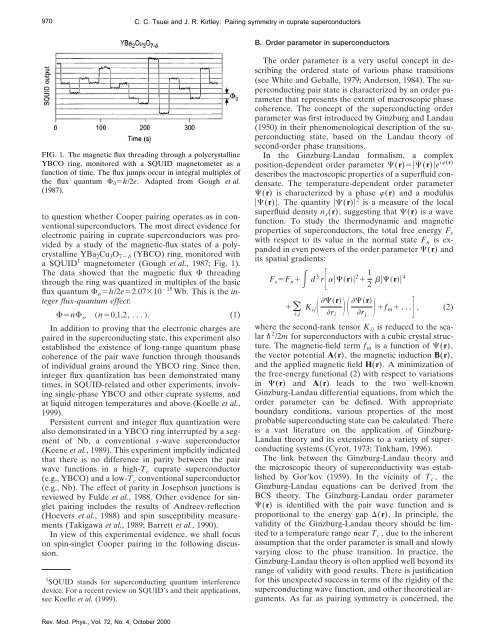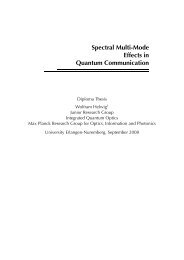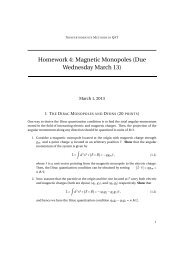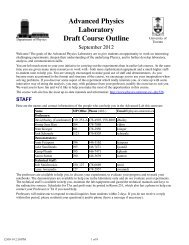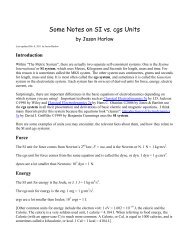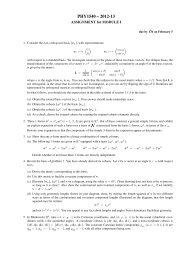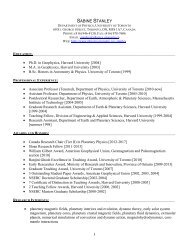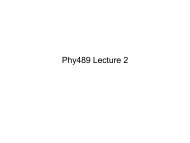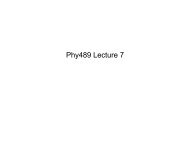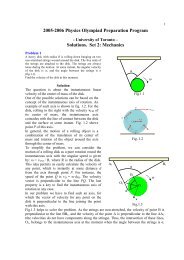Kirtley and Tsuei - Physics
Kirtley and Tsuei - Physics
Kirtley and Tsuei - Physics
Create successful ePaper yourself
Turn your PDF publications into a flip-book with our unique Google optimized e-Paper software.
970 C. C. <strong>Tsuei</strong> <strong>and</strong> J. R. <strong>Kirtley</strong>: Pairing symmetry in cuprate superconductors<br />
B. Order parameter in superconductors<br />
FIG. 1. The magnetic flux threading through a polycrystalline<br />
YBCO ring, monitored with a SQUID magnetometer as a<br />
function of time. The flux jumps occur in integral multiples of<br />
the flux quantum 0 h/2e. Adapted from Gough et al.<br />
(1987).<br />
to question whether Cooper pairing operates as in conventional<br />
superconductors. The most direct evidence for<br />
electronic pairing in cuprate superconductors was provided<br />
by a study of the magnetic-flux states of a polycrystalline<br />
YBa 2 Cu 3 O 7 (YBCO) ring, monitored with<br />
a SQUID 1 magnetometer (Gough et al., 1987; Fig. 1).<br />
The data showed that the magnetic flux threading<br />
through the ring was quantized in multiples of the basic<br />
flux quantum o h/2e2.0710 15 Wb. This is the integer<br />
flux-quantum effect:<br />
n o n0,1,2, . . . . (1)<br />
In addition to proving that the electronic charges are<br />
paired in the superconducting state, this experiment also<br />
established the existence of long-range quantum phase<br />
coherence of the pair wave function through thous<strong>and</strong>s<br />
of individual grains around the YBCO ring. Since then,<br />
integer flux quantization has been demonstrated many<br />
times, in SQUID-related <strong>and</strong> other experiments, involving<br />
single-phase YBCO <strong>and</strong> other cuprate systems, <strong>and</strong><br />
at liquid nitrogen temperatures <strong>and</strong> above (Koelle et al.,<br />
1999).<br />
Persistent current <strong>and</strong> integer flux quantization were<br />
also demonstrated in a YBCO ring interrupted by a segment<br />
of Nb, a conventional s-wave superconductor<br />
(Keene et al., 1989). This experiment implicitly indicated<br />
that there is no difference in parity between the pair<br />
wave functions in a high-T c cuprate superconductor<br />
(e.g., YBCO) <strong>and</strong> a low-T c conventional superconductor<br />
(e.g., Nb). The effect of parity in Josephson junctions is<br />
reviewed by Fulde et al., 1988. Other evidence for singlet<br />
pairing includes the results of Andreev-reflection<br />
(Hoevers et al., 1988) <strong>and</strong> spin susceptibility measurements<br />
(Takigawa et al., 1989; Barrett et al., 1990).<br />
In view of this experimental evidence, we shall focus<br />
on spin-singlet Cooper pairing in the following discussion.<br />
1 SQUID st<strong>and</strong>s for superconducting quantum interference<br />
device. For a recent review on SQUID’s <strong>and</strong> their applications,<br />
see Koelle et al. (1999).<br />
The order parameter is a very useful concept in describing<br />
the ordered state of various phase transitions<br />
(see White <strong>and</strong> Geballe, 1979; Anderson, 1984). The superconducting<br />
pair state is characterized by an order parameter<br />
that represents the extent of macroscopic phase<br />
coherence. The concept of the superconducting order<br />
parameter was first introduced by Ginzburg <strong>and</strong> L<strong>and</strong>au<br />
(1950) in their phenomenological description of the superconducting<br />
state, based on the L<strong>and</strong>au theory of<br />
second-order phase transitions.<br />
In the Ginzburg-L<strong>and</strong>au formalism, a complex<br />
position-dependent order parameter (r)(r)e i(r)<br />
describes the macroscopic properties of a superfluid condensate.<br />
The temperature-dependent order parameter<br />
(r) is characterized by a phase (r) <strong>and</strong> a modulus<br />
(r). The quantity (r) 2 is a measure of the local<br />
superfluid density n s (r), suggesting that (r) is a wave<br />
function. To study the thermodynamic <strong>and</strong> magnetic<br />
properties of superconductors, the total free energy F s<br />
with respect to its value in the normal state F n is exp<strong>and</strong>ed<br />
in even powers of the order parameter (r) <strong>and</strong><br />
its spatial gradients:<br />
F s F n d r 3 r 2 1 2 r4<br />
<br />
i,j<br />
K ij r<br />
r i<br />
r<br />
r j<br />
<br />
f m ... , (2)<br />
where the second-rank tensor K ij is reduced to the scalar<br />
2 /2m for superconductors with a cubic crystal structure.<br />
The magnetic-field term f m is a function of (r),<br />
the vector potential A(r), the magnetic induction B(r),<br />
<strong>and</strong> the applied magnetic field H(r). A minimization of<br />
the free-energy functional (2) with respect to variations<br />
in (r) <strong>and</strong> A(r) leads to the two well-known<br />
Ginzburg-L<strong>and</strong>au differential equations, from which the<br />
order parameter can be defined. With appropriate<br />
boundary conditions, various properties of the most<br />
probable superconducting state can be calculated. There<br />
is a vast literature on the application of Ginzburg-<br />
L<strong>and</strong>au theory <strong>and</strong> its extensions to a variety of superconducting<br />
systems (Cyrot, 1973; Tinkham, 1996).<br />
The link between the Ginzburg-L<strong>and</strong>au theory <strong>and</strong><br />
the microscopic theory of superconductivity was established<br />
by Gor’kov (1959). In the vicinity of T c , the<br />
Ginzburg-L<strong>and</strong>au equations can be derived from the<br />
BCS theory. The Ginzburg-L<strong>and</strong>au order parameter<br />
(r) is identified with the pair wave function <strong>and</strong> is<br />
proportional to the energy gap (r). In principle, the<br />
validity of the Ginzburg-L<strong>and</strong>au theory should be limited<br />
to a temperature range near T c , due to the inherent<br />
assumption that the order parameter is small <strong>and</strong> slowly<br />
varying close to the phase transition. In practice, the<br />
Ginzburg-L<strong>and</strong>au theory is often applied well beyond its<br />
range of validity with good results. There is justification<br />
for this unexpected success in terms of the rigidity of the<br />
superconducting wave function, <strong>and</strong> other theoretical arguments.<br />
As far as pairing symmetry is concerned, the<br />
Rev. Mod. Phys., Vol. 72, No. 4, October 2000


